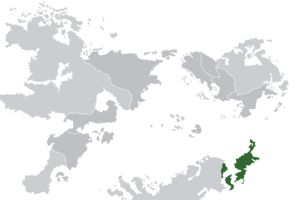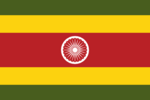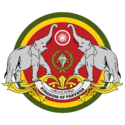Parvana
Kingdom of Parvana | |
|---|---|
| Motto: ഞങ്ങൾ കോമാനിക്ക് കീഴിൽ ഒരുമിച്ചിരിക്കുന്നു, മെച്ചപ്പെട്ട പർവനയ്ക്കായി പ്രവർത്തിക്കുന്നു "We are united under the Komani, working towards a better Parvana." | |
| Anthem: കോമണിക്ക് മഹത്വം "Glory to the Komani" | |
 Location of Parvana (green) in Donjon (grey) | |
| Capital and largest city | Pabhupuram |
| Official languages | Masayalum |
| Recognised regional languages | |
| Ethnic groups (2022) | |
| Religion (2022) | |
| Demonym(s) | Parvanese |
| Government | Federal parliamentary semi-constitutional monarchy |
| Chitra Varma | |
| Ishat Ram Sankar | |
| Indira Sahni | |
| Deepesh Bhai Subramanian | |
| Legislature | Parliament |
| Raja Sabha | |
| Janam Sabha | |
| Formation | |
• TBC | TBC |
| Population | |
• 2022 census | |
| GDP (nominal) | 2023 estimate |
• Total | ($3.569 trillion) (?) |
• Per capita | ($17,750) |
| Gini (2017) | medium |
| HDI (2022) | 0.664 medium |
| Currency | Parvanese ranee (₹) (PVR) |
| Time zone | TBC+? (Parvanese Standard Time) |
| Date format | dd-mm-yyyy or yyyy-mm-dd |
| Driving side | left |
| Calling code | +4 |
Parvana (Masalayum: പർവന), officially the Kingdom of Parvana, is a large country in east Isica, bordered to the north by Malava. It is situated mostly on several islands, with Kulungunadu being by far the largest, as well as a relatively small area on the mainland of the continent, known as Vankara. Parvana is split into 40 states and territories. The nation is divided not only by water, but also by mountain ranges which run down the middle of the country's two largest islands. This geographic division has also caused noticeable language and culture divisions within Parvana. It has a large urban population of around 140 million people, with the largest cities including the capital Pabhupuram, Shanticolani, Katavum and Rajakurapuram. Parvana has just over 200 million inhabitants of multiple native ethnicities.
Parvana has been inhabited for over 73,000 years, with the earliest recorded civilisations emerging in the Vaira and Puram Valleys around 3300 BCE. These civilisations lasted until around 800 BCE, when the first Parvanese dynasties were formed, these being the Bhudan and Pandya dynasties. These dynasties established the earliest forms of Masalayum and Kadali cultures, around 300 BCE, the Kiraar and Veruk dynasties were founded, establishing the foundations for the Kiraaru and Verukali cultures. Parvana's dynastic period was fairly stable, with dynasties opting for trade relations as opposed to war. It lasted until the 11th century, when the first Parvanese kingdom was established: the Kingdom of Malava and Vankara, which was situated on mainland Isica. In 1534, the Kingdom of Samthanum, the largest of the two kingdoms in the Two Kingdoms period, was succeeded by the Kingdom of Kulungunadu, after the bloodiest war in Parvanese history, which lasted for 13 years and resulted in over 8 million deaths. The Kingdom of Kulungunadu is considered the direct administrative predecessor to Parvana, as it was during this kingdom that many of Parvana's laws, social infrastructure and modern culture began, such as the Parvanese caste system, which is still found in modern urban regions of Parvana.
The end of the Two Kingdoms period came in 1727, with the end of Kulungunadu invasion of Malava and Vankara. The invasion had lasted since 1722, and took place due to the death of Kolakonda II of Malava and Vankara, who's son, Kolokonda III was massively disliked by the people of Vankara as he believed that Malavanese people were superior to the Kadali people of Vankara. King Darsanakalanidhi Varma decided to invade Vankara and integrate it into the Kingdom of Kulungunadu, however, after a successful invasion of Vankara, with minimal resistance from the people, Varma ordered troops to continue into Malava. The invasion of Malava was far less successful, and was met with a lot of resistance. After five years of fighting, the Malavanese troops surrendered and the Kingdom of Parvana was founded consisting of the original Kulungunadu Kingdom, Vankara and Malava.
Throughout the 18th and 19th centuries, resistance from the Malavanese continued. Initially, this resistance was minimal and manageable for the Parvanese government. However, it began increasing significantly in the late 19th and early 20th centuries. In 1916, the Republic of Malava was declared by the Malavanese Free Army, beginning the Malavanese War of Independence. This war lasted until 1921, with the signing of the Parvana-Malava Treaty. The success of the independence movement not only lead to sour relations between Parvana and Malava for several decades, but also lead to the implementation of anti-freedom of expression legislations by prime minister Vatsal Yayin to prevent further movements. He was succeeded in 1952 by Mayur Niranjan, who ruled under martial law as a dictator for thirty years until 1983 when he was arrested by royal decree by Queen Chitra Varma.
The Kingdom of Parvana is a member of the International Council of Nations, the Parvana-Malava Forum and TBD. Parvana claims to maintain a neutral foreign-policy, refraining from aligning itself with any of the ICN's Big Three. Despite its political neutrality, Parvana operates very strong economic relations with several countries around Donjon thanks to its large workforce and high resource output. As of 2023, Parvana has the fourth-largest economy by nominal gross domestic product (GDP) and has a high human development index.
History
Early history (until 1056)
The lands of Parvana have been inhabited for over 73,000 years, with the ancestors of all of Parvana's native ethnic groups settling there around 50,000 years ago. The first organized civilizations were the Vaira Valley and Puram River Civilisations which were recorded to have existed from around 3300 BCE until around 1300 BCE. In around 800 BCE, the first dynasties were founded: the Bhudan dynasty and the Pandya dynasty.
Two Kingdoms period (1056–1727)
These dynasties remained relatively stable and each lasted around a thousand years, with the Bhudan dynasty being succeeded by the Kingdom of Samthanum in 1137 and the Pandya dynasty being succeeded by the Kingdom of Malava and Vankara in 1056. The Kingdom of Samthanum would serve as the first Masalaya kingdom, and was responsible for spreading the language throughout the island of Kulungundu and as hostile relations between Samthanum and Vankara began developing into friendlier relations during the 16th century, they also began popularising Kaverism throughout both kingdoms. In 1534, the Kingdom of Samthanum was succeeded by the Kingdom of Kulungunadu after a 13-year long brutal war between people on the eastern and western sides of the islands resulting in over four million deaths on both sides. The Kingdom of Kulungunadu developed several administrative systems to manage with its multicultural population, and was responsible for the creation of Varna, also known as the Parvanese caste system. The caste system, which segregates people based on economic standing and familial history, has been declared as eradicated by the Parvanese government multiple times throughout the 20th and 21st centuries, however it is still culturally prevalent in multiple areas of Parvana, particularly large urban regions.
In 1722, the Kingdom of Kulungunadu invaded the Kingdom of Malava and Vankara. The invasion was caused by the accession of King Kolakonda III who was disliked by people in both Kulungunadu and in Vankara, however, he was well liked by the people of Malava. In order to prevent a civil war erupting in Malava, the Kulungunadu invaded Vankara with minimal resistance. Although King Darsanakalanidhi Varma of Kulungunadu had initially promised to only take Vankara, he ended up ordering the troops to continue into Malava in 1723 which was unsurprisingly met with increased resistance. The invasion lasted four years, until 1727, with the surrender of Malavanese troops and the execution of Kolakonda III. With the end of the war, the kingdom rebranded itself into the Kingdom of Parvana. Despite surrendering and accepting annexation into the kingdom, many Malavanese people were unhappy being under a Masalaya monarchy. This lead to frequent civil disruptions taking place within Malava, warranting the introduction of troops into the region. Throughout the late 19th century, troops would be permanently stationed in significant urban areas of the region. Malava was also considered the poorest region of the kingdom, with the Masalaya regions of South Kulungunadu and the island of Samrudhanadu being the richest regions of the country.
Early Kingdom of Parvana (1727–1916)
Malavanese War of Independence (1916–1921)
The economic and cultural separations between Malava and the rest of the kingdom lead to the beginning of the Malavanese War of Independence in 1916. The war was initiated with the declaration of the breakaway government of the Republic of Malava. In 1916 and 1917, the war was mostly reluctance to obey and orders given by the Parvanese police or military, resulting in the arrest or execution of hundreds of protesting people. However, in late 1917, after a raid on the breakaway state's headquarters by the Parvanese military, the Malavanese Free Army began a campaign to take over several local governments within the Malava region. They were mostly successful, with the majority of Malavenese politicians in favor of independence. The Free Army also offered a movement for Vankaran independence, however most Vankaran people were satisfied with their position within Parvana and the Vankaran government instead gave a warning to the central Parvanese government of the Malavanese' attempts to encourage an independence movement in the region. After four years of attacks on Parvanese government infrastructure in Malava and the arrests and executions of several thousand members of both sides, the Parvanese government ceded and signed the Parvana-Malava Treaty which let the region of Malava gain independence as the Republic of Malava. Although relations between the two countries initially remained moderately hostile, with both sides maintaining a strict militarized border, they have since loosened, particularly after the accession of Queen Chitra Varma in 1982 who publicly denounced the monarchy and government's resistance against Malavanese independence in 1985.
Martial law and the Niranjan regime (1921–1983)
After the conclusion of the Malavanese War of Independence, the government of Parvana, in fear of any more independence movements in Parvana, implemented several legislations restricting the political rights of civilians, banning freedom of speech against the government and prohibiting certain people from running for office. These changes were lead by prime minister Vatsal Yayin who declared himself as the Dictator of the Parvanese State between 1921 until his death in 1952, where he was succeeded by his close political ally Mayur Niranjan who ceased all elections and established martial law in Parvana after the 1953 Shanticolani bombing which was carried out by a member of a pro-Kiraari speaking regions independence movement. The period lead by Dictator Mayur Niranjan from 1952 to 1983 is known as the Niranjan regime and is commonly referred to in Parvana as "ഇരുട്ടിന്റെ കാലഘട്ടം" (Iruttinte kaalaktam; the Period of Darkness). After the death of King Nivrutti Varma in 1982, her daughter, Chitra Varma took over. Chitra had frequently expressed her disliking of Niranjan's regime and in 1983, gave a royal decree to arrest Niranjan for committing crimes against the state. Niranjan was arrested by the Parvanese Royal Guard on 18 June 1983 and imprisoned in Pabhupuram Territorial Prison. The first election in 30 years was called in September 1983 and resulted in the overwhelming success of the Royalist Party of Parvana and elected Nayan Ajeet as the next prime minister. The PRP has lead all elections in Parvana since Ajeet's election.

